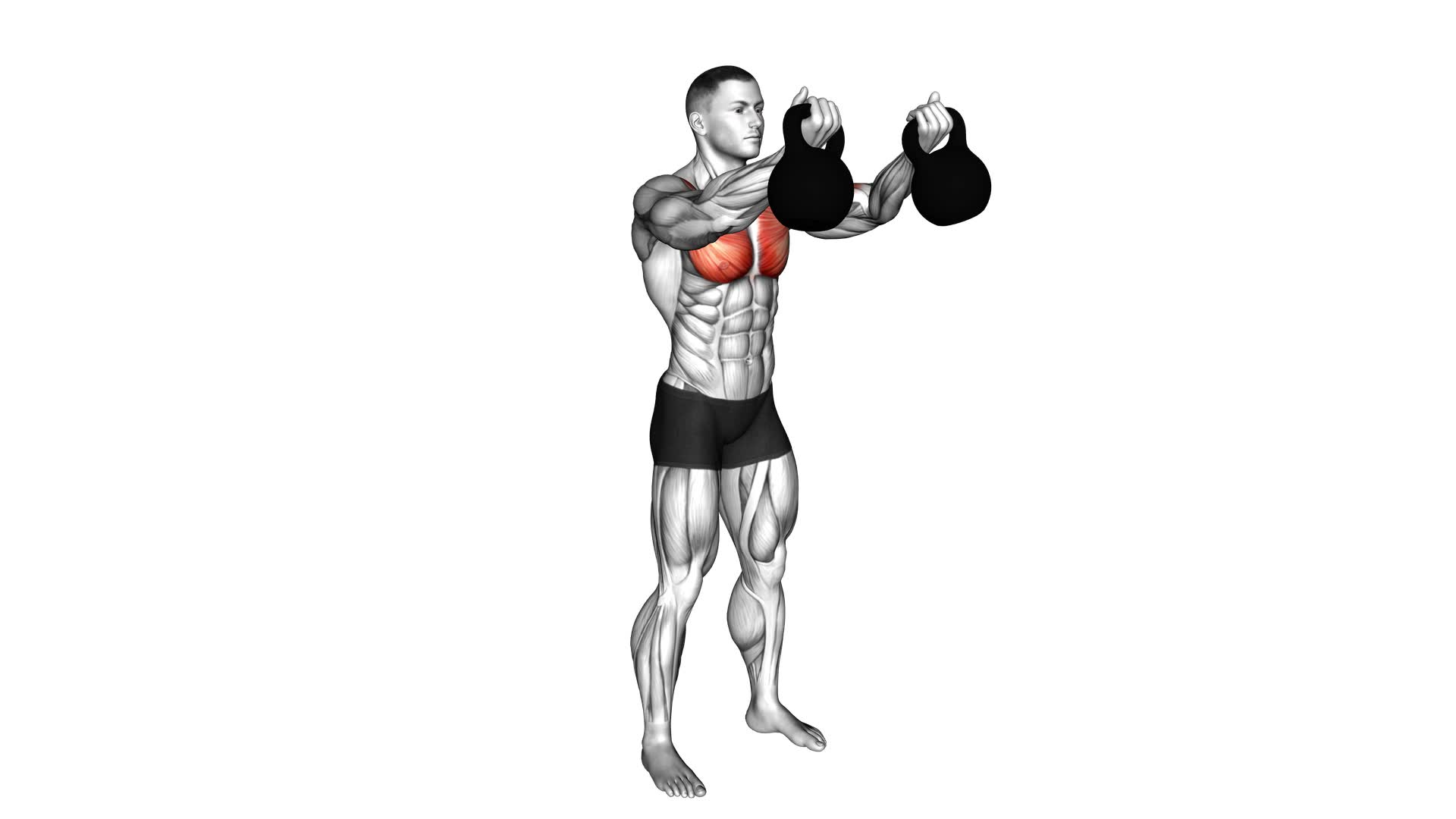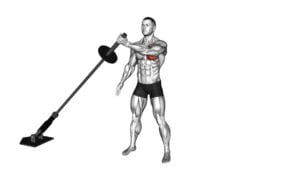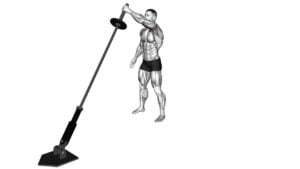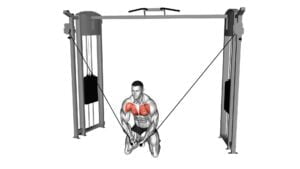Kettlebell Low Fly (male) – Video Exercise Guide & Tips

Are you looking for a challenging exercise that targets your chest and shoulders? Look no further than the kettlebell low fly.
Watch This Exercise Video
In this video exercise guide, we'll show you the proper form and technique for performing this exercise. Whether you're a beginner or an experienced fitness enthusiast, we've got variations and modifications to suit all fitness levels.
Learn how to avoid common mistakes and get tips for maximizing your kettlebell low fly workout.
Get ready to feel the burn!
Key Takeaways
- The Kettlebell Low Fly activates multiple muscles throughout the body, including the chest muscles and the muscles of the shoulders.
- Proper form and technique for the Kettlebell Low Fly include gripping the kettlebell with both hands, bending the knees slightly, and maintaining a straight back.
- Common errors to avoid during the Kettlebell Low Fly include using momentum or swinging the kettlebell, rounding the shoulders, and fully extending the arms at the top of the movement.
- Variations and modifications for all fitness levels include using a lighter kettlebell, performing the exercise with a slower tempo, reducing the range of motion for beginners, and increasing the weight of the kettlebell or performing the exercise on an unstable surface for intermediate/advanced individuals.
Benefits of the Kettlebell Low Fly
You will frequently experience the benefits of the Kettlebell Low Fly. This exercise is highly effective in activating multiple muscles throughout your body and improving core stability.
The Kettlebell Low Fly primarily targets the chest muscles, specifically the pectoralis major and minor. By performing this exercise, you'll notice increased muscle activation in your chest, helping to strengthen and tone this area.
In addition to targeting the chest, the Kettlebell Low Fly also engages the muscles of the shoulders, including the deltoids and trapezius. These muscles play a crucial role in stabilizing your shoulder joints and promoting better posture. By regularly incorporating the Kettlebell Low Fly into your workout routine, you can improve your shoulder strength and stability.
Furthermore, the Kettlebell Low Fly requires the engagement of your core muscles throughout the exercise. This includes the muscles of your abdomen, lower back, and hips. By maintaining proper form and control during the movement, you'll enhance your core stability and develop a stronger, more balanced midsection.
Proper Form and Technique
To perform the Kettlebell Low Fly exercise correctly, ensure proper form and technique. Here are some key tips to help you execute the exercise with precision and maximize muscle activation:
- Grip the kettlebell with both hands and stand with your feet shoulder-width apart.
- Begin by bending your knees slightly and hinging at the hips, keeping your back straight and core engaged.
- Lower the kettlebell towards the ground, allowing your arms to hang straight down and maintaining a slight bend in your elbows.
- Slowly raise the kettlebell back up to the starting position, focusing on using your chest and shoulder muscles to control the movement.
Common errors to avoid include:
- Using momentum: Don't swing the kettlebell or rely on momentum to lift it. Instead, focus on controlled movements and engage your muscles throughout the exercise.
- Rounded back: Keep your back straight and avoid rounding your shoulders or hunching over.
- Dropping the weight: Maintain a firm grip on the kettlebell throughout the exercise to prevent accidental dropping or injury.
- Overextending the arms: Avoid fully extending your arms at the top of the movement to prevent strain on your joints.
By performing the Kettlebell Low Fly exercise with proper form and technique, you can effectively target your chest and shoulder muscles.
Now, let's explore variations and modifications for all fitness levels.
Variations and Modifications for All Fitness Levels
There are three variations and modifications for all fitness levels when performing the Kettlebell Low Fly exercise. For beginners, it's important to start with a lighter kettlebell and focus on mastering the proper form and technique before progressing to more challenging variations. Adjustments for beginners include using a lighter kettlebell, performing the exercise with a slower tempo, and reducing the range of motion. These modifications allow beginners to build strength and stability in the shoulder and chest muscles while minimizing the risk of injury.
For intermediate and advanced fitness levels, there are progression options for the Kettlebell Low Fly exercise. One option is to increase the weight of the kettlebell to add more resistance and challenge the muscles further. Another option is to perform the exercise on an unstable surface, such as a BOSU ball, to engage the core muscles and improve balance. Lastly, incorporating a pause at the bottom of the movement can increase the time under tension and enhance the muscle-building benefits of the exercise.
Common Mistakes to Avoid
To avoid common mistakes, ensure that you maintain proper form and technique while performing the Kettlebell Low Fly exercise. Here are four common mistakes to avoid:
- Using too heavy of a kettlebell: It's important to choose a kettlebell that's appropriate for your strength and fitness level. Using a weight that's too heavy can compromise your form and increase the risk of injury. Start with a lighter weight and gradually increase as you build strength and confidence.
- Arching your back: Keep your back straight and avoid arching it during the exercise. Arching the back puts unnecessary strain on the spine and can lead to back pain. Engage your core muscles and maintain a neutral spine throughout the movement.
- Dropping the kettlebell too low: The kettlebell shouldn't drop below your shoulder level during the exercise. Lowering it too much can strain the shoulders and compromise your form. Keep the kettlebell at a comfortable height, slightly below shoulder level, and maintain control throughout the movement.
- Rushing the movement: Take your time and focus on performing the exercise with proper form and control. Rushing through the movement can lead to sloppy technique and increase the risk of injury. Slow and controlled movements will help you target the muscles effectively and get the most out of the exercise.
Tips for Maximizing Your Kettlebell Low Fly Workout
To maximize your Kettlebell Low Fly workout, focus on maintaining proper technique and form, while incorporating these key tips.
Firstly, pay attention to your breathing techniques during the exercise. Exhale as you lift the kettlebell, and inhale as you lower it. This controlled breathing will help stabilize your core and enhance your overall performance.
Additionally, consider incorporating the kettlebell low fly into a full body workout routine. This exercise primarily targets the chest and shoulders, but it also engages the core, back, and arms. To optimize your results, combine the kettlebell low fly with other exercises that target different muscle groups. This way, you can achieve a well-rounded workout that maximizes calorie burn and muscle development.
When adding the kettlebell low fly to your routine, start with a weight that challenges you but allows you to maintain proper form. Gradually increase the weight as you become more comfortable and stronger. Remember, it's crucial to prioritize technique and form over the amount of weight you lift.
Frequently Asked Questions
How Many Calories Can I Burn by Doing the Kettlebell Low Fly Exercise?
By doing the kettlebell low fly exercise, you can burn calories and get a great workout. This exercise targets your chest, shoulders, and arms, helping to build strength and tone muscles.
While the exact number of calories burned may vary depending on factors like weight and intensity, kettlebell exercises are known for their ability to burn calories efficiently.
If you're a beginner, it's important to start with a lighter weight and focus on proper form to avoid injury.
Is the Kettlebell Low Fly Suitable for Beginners?
The kettlebell low fly can be suitable for beginners with proper form and caution.
To perform this exercise correctly, start by lying on your back with your knees bent and feet flat on the floor.
Hold the kettlebell with both hands extended over your chest.
Slowly lower the kettlebell towards the floor, keeping your arms slightly bent.
Avoid the common mistakes of using too heavy of a weight and arching your back.
Can the Kettlebell Low Fly Help in Building Chest Muscles?
The kettlebell low fly is an effective exercise for building chest muscles. By incorporating kettlebell exercises into your workout routine, you can experience a range of benefits, including increased strength, muscle definition, and improved posture.
To perform the kettlebell low fly properly, maintain a stable stance, engage your core, and keep your elbows slightly bent. Focus on controlling the movement and squeezing your chest muscles at the top of the exercise.
Remember to start with a weight that's suitable for your fitness level.
Are There Any Alternative Exercises That Can Be Done Instead of the Kettlebell Low Fly?
Looking for alternative exercises to the kettlebell low fly?
There are plenty of options to help you build chest muscles. Push-ups are a classic exercise that targets your chest, as well as dumbbell chest presses and cable chest flies.
Incorporating these exercises into your routine can provide similar benefits to kettlebell training. Remember to focus on maintaining proper form and gradually increasing weight to maximize your results.
How Often Should I Incorporate the Kettlebell Low Fly Into My Workout Routine for Optimal Results?
To maximize your results and optimize your workout routine, it's important to consider the frequency of incorporating the kettlebell low fly exercise.
The ideal workout frequency for this exercise may vary depending on your fitness goals and current fitness level. It's generally recommended to include the kettlebell low fly exercise in your routine 2-3 times a week.
However, it's always best to consult with a fitness professional or trainer to tailor your workout frequency to your specific needs and goals.
Conclusion
In conclusion, the kettlebell low fly is a highly beneficial exercise that can help strengthen and tone the chest muscles. By maintaining proper form and technique, individuals of all fitness levels can safely perform this exercise.
It's important to avoid common mistakes and follow the provided tips for maximizing the effectiveness of the workout. Incorporating the kettlebell low fly into your fitness routine can lead to improved upper body strength and overall fitness.

Author
Years ago, the spark of my life’s passion ignited in my mind the moment I stepped into the local gym for the first time. The inaugural bead of perspiration, the initial endeavor, the very first surge of endorphins, and a sense of pride that washed over me post-workout marked the beginning of my deep-seated interest in strength sports, fitness, and sports nutrition. This very curiosity blossomed rapidly into a profound fascination, propelling me to earn a Master’s degree in Physical Education from the Academy of Physical Education in Krakow, followed by a Sports Manager diploma from the Jagiellonian University. My journey of growth led me to gain more specialized qualifications, such as being a certified personal trainer with a focus on sports dietetics, a lifeguard, and an instructor for wellness and corrective gymnastics. Theoretical knowledge paired seamlessly with practical experience, reinforcing my belief that the transformation of individuals under my guidance was also a reflection of my personal growth. This belief holds true even today. Each day, I strive to push the boundaries and explore new realms. These realms gently elevate me to greater heights. The unique combination of passion for my field and the continuous quest for growth fuels my drive to break new ground.







